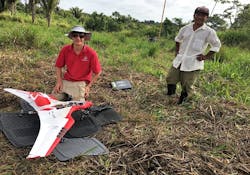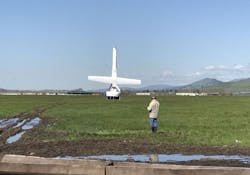Beyond line of sight UAS testing, new signal intelligence sensor for drones
In this week’s article from the Association for Unmanned Vehicle Systems International (AUVSI), which highlights some of the latest news and headlines in unmanned vehicles and robotics, we take a look atmore beyond line of sight UAS flight testing, as well as a successful test on a modular signal intelligence sensor that provides data such as signal identification, signal copy and geolocation for both UAS and manned aircraft of varying sizes.
University of Maryland researchers conduct BLOS flights in Belize
In January, researchers from the University of Maryland (UMD) conducted beyond-line-of-sight UAS flights that were aimed at getting an understanding on how villages in Belize use "slash-and-burn agricultural practices, known as swidden, to sustainably manage shared natural resources.
The flights, which were the second aerial scan of the region to take place in less than a year, were flown by an anthropologist named Sean Downey, and an engineer with UMD’s UAS Test Site named Jacob Moschler.
After receiving clearance from the Belize Department of Civil Aviation, a total of 10,000 acres in and around the Q’eqchi’ Maya village of Crique Sarco in Belize’s Toledo District were scanned using a pair of FireFLY 6 UAS. The flights were conducted more than four miles away from a makeshift ground control station, from an altitude of 1,500 feet.
A total of 31,000 images in five discrete wavelengths were captured during the flights, thanks to mounted Micasense Red Edge multispectral cameras.
The cameras, in combination with first-person view goggles, also gave members of the community the opportunity to view live aerial images of their village and community forests for the very first time.
Over the next several months, Downey and his research team will stitch the images together into landscape-scale maps, that they will use to analyze social and ecological dynamics related to the slash and burn agricultural practices.
To further understand the social dynamics related to these practices, surveys, interviews other ethnographic methods, and methods used in experimental behavioral economics, will also be used as well.
A third round of mapping is scheduled for spring of next year. With a mind towards making that operation fully autonomous, Moschler and UMD systems engineer John S. Baras will spend the next year working to create optimized scan patterns. They will also look to upgrade hardware so that they can maintain the strong GPS signal necessary for autonomous flight.
VStar Systems successfully tests its modular signal intelligence sensor on Martin UAV V-Bat
VStar Systems Inc. has announced that it successfully conducted a flight test of its modular Signal Intelligence Sensor, the MA-C/lite, installed upon the Martin UAV V-Bat aircraft.
The MA-C/lite is one of VStar’s MA-C products designed to provide signal intelligence, such as signal identification, signal copy and geolocation for both UAS and manned aircraft of varying sizes.
The MA-C/lite provides SIGINT to Martin UAV’s line of V-Bat unmanned systems, giving the aircraft the ability to perform a variety of missions for both military and private security clients.
Over the course of 35 minutes during the flight, the MA-C/lite collected signals from a distance as far away as 20 miles, while flying at a height of 400 feet above ground level.
The MA-C/lite is just one of a number of products under the MA-X Modular Airborne Signal Intelligence System, which is built to provide critical intelligence at a decent price.
VStar hopes to commoditize SIGINT, which would allow smaller aircraft to avoid having to carry unnecessary weight (resulting in more costs), thanks to having a single, specialized module, such as the MA-C/lite.
Precision Vectors selects Silent Falcon UAS as exclusive UAS for BVLOS flights
Precision Vectors Aerial Inc. has selected the Silent Falcon UASas the exclusive unmanned system to carry out its beyond-visual-line-of-sight flights for its unmanned aerial services business.
As a part of the agreement, the Silent Falcon UAS will be distributed around Canada by Precision Vectors.
"Our decision to work exclusively with Silent Falcon is founded on our assessment that it is by far the most advanced and commercially viable UAV for operations BVLOS," says Precision Vectors President Lorne Borgal.
"No other UAV has the solar voltaic wing, sophisticated payload bay and inaudible flight performance of Silent Falcon."
Some of the features of the Silent Falcon UAS that make it the ideal system for Precision Vectors are its ability to carry multiple payloads, its ability to operate silently, and its ability to perform long endurance, long range flights.
View more information on the AUVSI.
Share your vision-related news by contacting James Carroll, Senior Web Editor, Vision Systems Design
To receive news like this in your inbox, click here.
Join our LinkedIn group | Like us on Facebook | Follow us on Twitter
Learn more: search the Vision Systems Design Buyer's Guide for companies, new products, press releases, and videos
About the Author

James Carroll
Former VSD Editor James Carroll joined the team 2013. Carroll covered machine vision and imaging from numerous angles, including application stories, industry news, market updates, and new products. In addition to writing and editing articles, Carroll managed the Innovators Awards program and webcasts.


